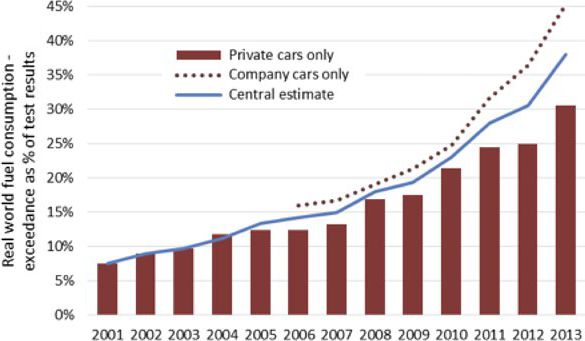T&E: Car makers increasingly manipulate EU fuel economy data
7 November 2014
Transport & Environment (T&E), a Belgium-based transport policy group, released a new report accusing car manufacturers of manipulating fuel economy tests in order to produce inflated car fuel economy figures that are not representative of fuel consumption in real world driving. The 2014 Mind the Gap report highlights the alleged abuses of the current fuel economy tests by carmakers and the “failure of EU regulators to close loopholes”.
The official NEDC test cycle has been long known to produce fuel consumption results that can be significantly lower than those in real driving. The NEDC procedure is expected to be replaced by a new, more realistic test cycle, the WLTP.
However, the gap between regulatory test results and real driving fuel consumption has been increasing in the recent years, which suggests that car makers may be purposefully exploiting the NEDC procedure to produce favorable fuel consumption and CO2 emission results. The gap between real-world fuel consumption and carmakers’ data has widened from 8% in 2001 to 31% in 2013 for private motorists; the gap for company car drivers averages 43%, concludes T&E. These figures are based on recent studies by the ICCT and by Emissions Analytics.

This growing gap between official and the real world results means that mandatory CO2 emission reductions are met only in the laboratory, while CO2 emissions in real driving do not follow the regulatory emission targets. According to the T&E analysis, the EU fleet-average CO2 emission reduction between 2008 and 2013—officially 31 g/km—can be split into only 13.6 g/km of real world emission reduction and an artificial decrease of 17.4 g/km due to the increasing gap between official and real world performance.
Among car makers, the biggest gap between official figures and real world performance exists in models by Daimler, followed by BMW and Ford (all above 30% discrepancy). The lowest average difference, of about 25%, was found in vehicles by Toyota, PSA and Fiat.
For specific car models, the biggest gaps exist for the smallest vehicles. For example, the average gap for the VW Golf jumped from 20% to 30% in 2013 and for the Ford Fiesta from 22% to 38%. This appears to be driven by the lower tax rates and/or exemptions often available for low carbon models that are very appealing to customers. On the road, the smallest engine vehicles are not more efficient than those with 1-2 L engines, concluded T&E.
Common methods used by manufacturers to manipulate test results include—according to T&E—using higher gears during the test, optimizing engine controls, disconnecting the alternator, lubricant selection, using special tires and overinflating them, and more.
While the EU fuel economy figures appear not to have been questioned by the European authorities—apparently an indication of a weak enforcement system—irregularities in fuel economy data submitted by several manufacturers have been discovered by recent audit tests conducted by the US Environmental Protection Agency (EPA). In particular, both the Mercedes C300 4-matic and the 2014 BMW Mini Cooper 3-Door were found to have values that differed from those submitted to the US EPA at the time of certification. While both vehicles were in compliance with the emission standards, their fuel economy label values were affected and had to be adjusted to show higher fuel consumption.
Source: T&E